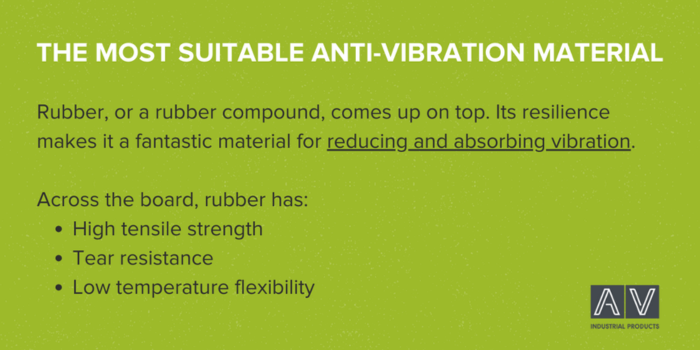
Making use of an anti vibration material is imperative in a number of industries. Vibration control is needed, especially in sectors such as manufacturing, construction and engineering. Without it, equipment can deteriorate, vibration can cause disturbance and employees can become susceptible to health complications as a result of excessive vibration. But what is the best anti vibration material? Today our team is going to give you a glimpse into vibration control materials, as well as provide an overview of the best anti vibration material.
Firstly, Why Is Anti Vibration Material Needed?
As a leading stockist of anti vibration parts and materials, we are acutely aware of the risks associated with excessive vibration. Take the construction industry, for example. Equipment that generates vibration can quickly deteriorate if anti vibration components are not utilised. Moreover, without vibration control within the equipment, and appropriate PPE, excessive vibration can cause health complications. The range of complications that can occur through vibration is astonishing: which is outlined, in depth, in another one of our articles. This can be accessed here.
In summary, handling equipment which generates high amounts of vibration, without the use of PPE, can cause life long complications such as Hand-Arm Vibration Syndrome (HAVS). As you can see, anti vibration material and compounds are absolutely essential, not only to protect the life of a machine but also to protect the health and safety of the operator.
The Best Anti Vibration Material Explained
In the anti vibration material debate, rubber, or a rubber compound, usually comes up on top. Across the board, rubber has high tensile strength, tear resistance, and low temperature flexibility, however one of the most important properties that rubber provides is resilience, which makes it a fantastic material for reducing and absorbing vibration. Depending on the application however, there are different categories of rubber.
Many people assume that rubber is rubber, and that it is only one tangible material. There are a number of different types of rubber however, as well as rubber compounds. The different types of rubber commonly fall into two distinct categories: natural and synthetic rubber. Natural rubber is, as you could have guessed, made from naturally occurring materials that are sourced from the Hevea brasiliensis (rubber tree). Synthetic rubber, on the other hand, is manufactured in laboratories. In the anti vibration industry Natural rubber is the material of choice, as it provides superior resilience compared to its synthetic equivalents. However, where natural rubber cannot be used, for example in high temperature environments, synthetic materials should be chosen.
The Process at AV Industrial Products
Here at AV Industrial Products, we manufacture a range of anti vibration products using high quality natural and synthetic rubbers. Our decades of experience enable us to design products utilising the best rubber compounds, providing high tensile strength of rubber, along with high resilience anti vibration properties, which make rubber an excellent material for the construction of bobbin mounts, bump stops, levelling feet and more.
We manufacture and distribute some of the highest quality rubber products available, so you can be sure that your critical machinery is well protected. Moreover, you can have ultimate peace of mind that users of key equipment are going to be protected against excessive vibration. If you have any questions about the material used to construct our products, or anything related to the above article, feel free to contact us today.




